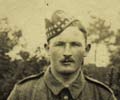In Memory ofGEORGE MITCHELL ANDERSONLance Corporal
|
|
Additional Information: Click on images to view details
|
Son of George and Jane Anderson, of Mosstown, Kennethmont, Aberdeenshire. George Anderson d Mosstown 25/8/1944 age
81, Jane Ann Boyd d there 26/12/1940 age 76 He was born at Kennethmont and enlisted at Insch, killed in action, served France & Flanders. PRO; 1914 Star, War & Victory Medals, France10/11/1914 B Cert : b Roadside, Clatt 22/2/1889 As a member of "H" Company 6GH (Territorial Force) Pte George Anderson reported to Company HQ at Huntly following the order to mobilize on 4th August 1914 and proceeded to France with the battalion (BEF) on 9th November. This qualified him for the 1914 or Mons Star in addition to the British War and Victory Medals. ( Book, 6 GH in F & F) 1/4/1908 The original Volunteer Battalions
was reorganised and the 4th became the 6th Batt ( Territorial
Force) comprising 8 companies centred in the following areas; 6GH War Diary entries Service notes 4/8/1914 at Keith: Gordon Brigade, Highland
Division. |
Commemorative Information
| Memorial: | LOOS MEMORIAL, Pas de Calais, France |
| Grave
Reference/ Panel Number: |
Panel 115 to 119 |
| Location: |
Loos-en-Gohelle is a village about 5 kilometres north-west of Lens. The Loos Memorial forms the side and back of Dud Corner Cemetery where over 1,700 officers and men are buried, the great majority of whom fell in the Battle of Loos. Dud Corner Cemetery, which stands almost on the site of a German strong point, the Lens Road Redoubt, captured by the 15th (Scottish) Division on the first day of the battle, is located about 1 kilometre west of the village, on the N43, the main Lens to Bethune road. The Loos Memorial commemorates over 20,000 officers and men who fell in the area from the River Lys to the old southern boundary of the First Army, east and west of Grenay, and who have no known grave. It covers the period from the first day of the Battle of Loos to the date of the Armistice. On either side of the cemetery is a wall 15 feet high, to which are fixed tablets on which are carved the names of those commemorated. At the back are four small circular courts, open to the sky, in which the lines of tablets are continued, and between these courts are three semicircular walls or apses, two of which carry tablets, while on the centre apse is erected the Cross of Sacrifice. |


